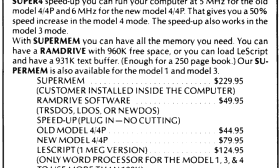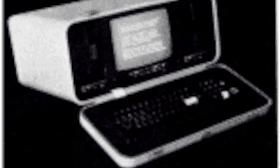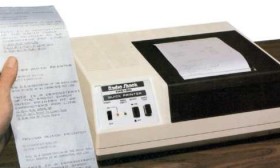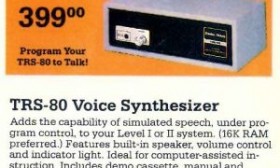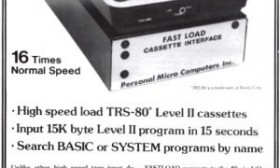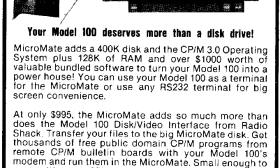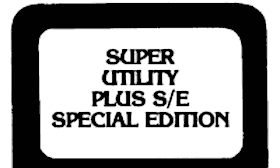The Alpha Technology Supermem was one of the most popular memory expansion options for the TRS-80. Alpha Technology (not to be confused with the similarly named Alpha Products) introduced the Supermem in 1985 for the Model I, Model III, and Model 4 in four memory sizes:
(Read more...)
Before laptop computers, there were transportable computers. Transportable computers (sometimes known as “portables” or “luggables”) were smaller than ordinary microcomputers and could be quickly moved and set up at a new location. Unlike laptop computers (which had yet to be invented) transportable computers had no batteries and needed to be set up and plugged into an outlet before they could be used.
Starting around 1981, there was a trend toward transportable computers. The Osborne 1 (introduced in 1981) and Kaypro II (introduced in 1982) were notable examples of CP/M transportables. The Compaq Portable (introduced in 1983) was probably the most famous MS-DOS transportable and the product that created the Compaq brand.
The Adcock & Johnson Model 3000, introduced in the spring of 1982, was a third-party TRS-80 entry in the transportable market. The Model 3000 consisted of an actual TRS-80 Model III converted into a transportable computer, either as a factory conversion or as a kit.
(Read more...)
The TRS-80 Model I (originally known as the TRS-80 Microcomputer System) was introduced by Radio Shack on August 3, 1977. It was one of the first mass-marketed, fully-assembled microcomputers and quickly became the best-selling personal computer.
Yet despite continued demand, Radio Shack discontinued the Model I on January 1, 1981, slightly less than three and a half years after it was first introduced. The culprit was not customer demand (which remained high) but new radio interference regulations from the United States Federal Communications Commission (FCC) which took effect on that date.
(Read more...)
The TRS-80 Quick Printer (catalog number 26-1153) was an early TRS-80 printer sold by Radio Shack. Introduced in 1978 for a price of $499.00, the Quick Printer was actually a rebranded Centronics Microprinter P1.
Unlike the more common dot-matrix or daisy-wheel printers (such as the TRS-80 Line Printer or the Daisy Wheel Printer II), the Quick Printer was an “electrostatic” printer that required special aluminum-coated paper. Radio Shack sold a package of three rolls of the 4.75″ wide “aluminized electrostatic spool paper” (catalog number 26-1405) for $16.95.
(Read more...)
Panik was not based on any particular arcade game; as one advertisement described it: “It has a little of all arcade games built in, but is its own original game.” It was written by William Demas, author of three other games for the TRS-80:
- Scott Adams' Adventure #12 (sold by Adventure International)
- Forbidden Planet (sold by Fantastic Software)
- Forbidden City (sold by Fantastic Software)
One of the advertisements for Panik contained this overview:
(Read more...)
The TRS-80 Voice Synthesizer (catalog number 26-1180) was a speech synthesizer unit sold by Radio Shack. Introduced in 1979 for a price of $399.00, the unit was only compatible with the TRS-80 Model I; Radio Shack never sold a TRS-80 Model III version.
The TRS-80 Voice Synthesizer plugged directly into the Model I expansion port and worked with both Level I and Level II BASIC systems. Like most voice synthesizers at the time, it worked by outputting words already broken into phonemes, or very small units of sound. It was described this way by the product introduction (under the headline of “Your TRS-80 Speaks!"):
(Read more...)
The FASTLOAD cassette interface used a novel (and patented) method of speeding up loading cassette programs on a TRS-80 Model I. By using a specially modified cassette recorder permanently in fast-forward mode (the equivalent of the fast-forward button always being pressed), FASTLOAD increased cassette loading speeds up to sixteen times to as high as 8000 baud. FASTLOAD was introduced in 1981 by Personal Micro Computers, Inc. (also known as PMC) for a price of $188.00. The modified CTR-41 cassette recorder, required to use FASTLOAD, cost $95.00. Personal Micro Computers also sold FASTLOAD as an option for their PMC-80 and PMC-81 Model I compatible computers.
The FASTLOAD cassette interface connected to the Model I I/O connector and used a built-in ROM to add a new cassette loading routine (mapped to the LOAD command), keyboard debounce routine, automatic key repeat, and a key click feature. Upon startup, a single SYSTEM command was required to enable the FASTLOAD interface routines.
(Read more...)
The PMC MicroMate was a CP/M workstation introduced in April 1983 for the price of $1195.00, although that price was later reduced. It was sold by Personal Micro Computers, Inc, also known as PMC, already well known for the Model I compatible PMC-80 and PMC-81 computers. Although the computer lines were not really equivalent, the MicroMate replaced both the PMC-80 and PMC-81. The MicroMate was manufactured by PMC but also resold by TRIOS Micro Systems until late 1984 and was sometimes relabeled by them.'
The MicroMate, officially known as the PMC-101, featured a Z80A processor with 128K of memory and an integrated 5 1/4" floppy drive. The whole computer fit in a case the size of an external drive enclosure. In fact, the unit resembled the external drive units used on a TRS-80 Model I. The MicroMate had no keyboard or video display but was billed as a “Terminal Expander,” designed to be used with any terminal to run CP/M programs. In addition to CP/M 3.0, the MicroMate also came with the T/Maker integrated software package.
(Read more...)
In late 1982, PowerSOFT began advertising the “Super Utility Plus Special Edition.” The package, sometimes referred to as “Super Utility Plus S/E,” was a premium limited-edition version of Super Utility. Only 500 packages were produced and each cost $500.00, including shipping. PowerSOFT took reservations for several months and began shipping on January 20, 1983.
Each Special Edition was numbered (1 to 500) and each was personally signed by Kim Watt. In addition to the Super Utility manual, it also came with two books:
(Read more...)
“The Assembly Line” was a column about assembly language programming which first appeared in the April 1980 issue of 80 Microcomputing. It was written by William Barden, well known for his books about assembly language such as the Z80 Microcomputer Handbook, TRS-80 Assembly Language Programming, and Programming Techniques for Level II BASIC. The first “Assembly Line” column began with these words:
This is the first of what I hope will be many columns devoted to TRS-80 assembly language programming. Judging from articles I’ve read and comments I’ve heard at users' groups, many of you are interested in assembly language. I’ll provide tutorial material on the more difficult aspects of assembly-language routines that you can use with BASIC programs or other assembly-language code.
(Read more...)
